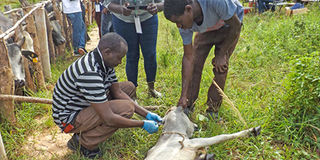Win for villagers as scientists curb deadly tsetse flies

A scientists draws blood from an animal to determine if it is infected with tsetse fly-borne diseases. Tsetse flies mainly cause trypanosomiasis in both humans and animals. PHOTO | BOZO JENJE | NATION MEDIA GROUP
What you need to know:
- For years, scientists note the village was one of the areas in the country that had a high prevalence of tsetse flies because of the wild animals.
But things have changed for the better, enabling residents like Josephine Wayua, a widow, to keep cattle. - The repellent, fitted on cattle collar, repulses any flies that target to bite the animals. Wayua, who received training from Icipe, can identify the flies and set traps to complement the collar.
- The London School of Hygiene and Tropical Medicine-trained scientist says in developing the collar technology, four chemicals were introduced on a material resembling foam and released at a slow rate as the waterbuck does.
- The gadget worn on the cattle necks is light, allowing the animal to move with ease. He adds that the strategy to control tsetse flies is tailor-made for the pastoralist community.
Tangini village in Kwale County borders Shimba Hill Park, an evergreen conservation facility famed for its rare Sable antelope. The village is located about a kilometre from the park, which harbours various wild animals.
For years, scientists note the village was one of the areas in the country that had a high prevalence of tsetse flies because of the wild animals.
But things have changed for the better, enabling residents like Josephine Wayua, a widow, to keep cattle.
This follows research work by scientists from the International Centre of Insect Physiology and Ecology (Icipe) to curb the pest.
Wayua keeps 12 cattle, enabling her to earn income by selling milk and ploughing residents’ farms at Sh2,500 per acre.
“We are now about 500 livestock farmers in the area with some 5,000 animals,” she says, attributing the success to a tsetse-repellent technology introduced by scientists.
The repellent, fitted on cattle collar, repulses any flies that target to bite the animals. Wayua, who received training from Icipe, can identify the flies and set traps to complement the collar.
“We also earn from maintaining the traps within the community as a sustainable extension system,” she narrates. To keep away the flies, the livestock pens should be kept clean and dried droppings removed and used as manure.
Icipe disease vector ecologist, Dr Michael Okal, says the technology to curb tsetse flies came after realisation that flies disliked the smell of a waterbuck.
FOR PASTORALIST COMMUNITIES
“The flies use the sense of smell to selectively bite animal. So we selected the body odour of the animal that the flies don’t bite,” he says.
The London School of Hygiene and Tropical Medicine-trained scientist says in developing the collar technology, four chemicals were introduced on a material resembling foam and released at a slow rate as the waterbuck does.
“When the tsetse fly approaches the animal, the technology releases the repellent from dispensers that smell like the waterbuck, pushing away the flies but not killing them. This is effective for farmers.”
The gadget worn on the cattle necks is light, allowing the animal to move with ease. He adds that the strategy to control tsetse flies is tailor-made for the pastoralist community.
“The pest used to kill at least three million cattle in the country every year but the numbers have gone down since the innovation. The collar and chemicals are safe and environment-friendly,” Dr Okal notes, adding that the cattle that wear the collar also protect the goats and humans from bites.
Tsetse flies cause trypanosomiasis in both humans and animals. To check whether the animal has been affected by tsetse flies, blood is drawn from the ear using a syringe and put in a centrifuge machine and rotated for some minutes. Afterwards it is screened using a microscope.
“After rotating, the cells of the parasite stay at the top of the sample of the blood,” explains Dr Okal, noting it currently costs Sh100 to buy the collar. The repellent lasts six months, after which the farmer refills at Sh80,” he says, adding that the technology is sustainable since bio-pesticides are used.





